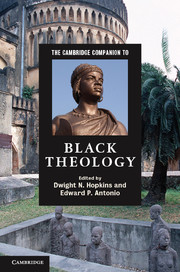Book contents
- Frontmatter
- Part I Introduction
- 1 General introduction
- 2 Historical perspective
- 3 Black theology and liberation theologies
- 4 The social sciences and rituals of resilience in African and African American communities
- 5 Black theology and womanist theology
- Part II Themes in black theology
- Part III Global expressions of black theology
- Further reading
- Index
- Other titles in the series
2 - Historical perspective
from Part I - Introduction
Published online by Cambridge University Press: 28 September 2012
- Frontmatter
- Part I Introduction
- 1 General introduction
- 2 Historical perspective
- 3 Black theology and liberation theologies
- 4 The social sciences and rituals of resilience in African and African American communities
- 5 Black theology and womanist theology
- Part II Themes in black theology
- Part III Global expressions of black theology
- Further reading
- Index
- Other titles in the series
Summary
BLACK RELIGION
From the earliest years of their captivity, transplanted Africans, denied access to other forms of self-affirmation and collective power, have used religion and its various institutions as the principal expression of their peoplehood and their will both to exist and to improve their condition. Black religion, characterized by fluctuation between moods of protest and accommodation, and protesting in the context of accommodating strategies, has contributed considerably to the ability of African American people to survive the worst forms of oppression and dehumanization. Beyond mere survival, as leaders and followers became more sophisticated about how to make the most of their religion, it has helped them liberate themselves, first from chattel slavery, then from ignorance and degradation, and finally – though still imperfectly – from civil inequality and subordination, to go on to greater heights of personal and group achievement.
In a classic essay on black religion, W. E. B. DuBois wrote: “Three things characterized this religion of the slave – the Preacher, the Music, and the Frenzy.” Although this classic description captures the dynamic of the Africans' earliest appropriation of evangelical Protestantism on both sides of the Atlantic, contemporary historical studies reveal a more complex and comprehensive pattern of religious development. From a perspective that includes not only what DuBois called “an adaptation and mingling of heathen rites … roughly designated as Voodooism,” but also the institutionalization of incipient slave worship in black American churches of the nineteenth and twentieth centuries, three dominant themes or motifs stand out as foundational from the August 1619 Jamestown, Virginia, landing of the first forced arrival of Africans to the present. They are survival, elevation, and liberation.
- Type
- Chapter
- Information
- The Cambridge Companion to Black Theology , pp. 19 - 32Publisher: Cambridge University PressPrint publication year: 2012



